transmission oil CHEVROLET KODIAK 2007 Owners Manual
[x] Cancel search | Manufacturer: CHEVROLET, Model Year: 2007, Model line: KODIAK, Model: CHEVROLET KODIAK 2007Pages: 430, PDF Size: 6.06 MB
Page 102 of 430
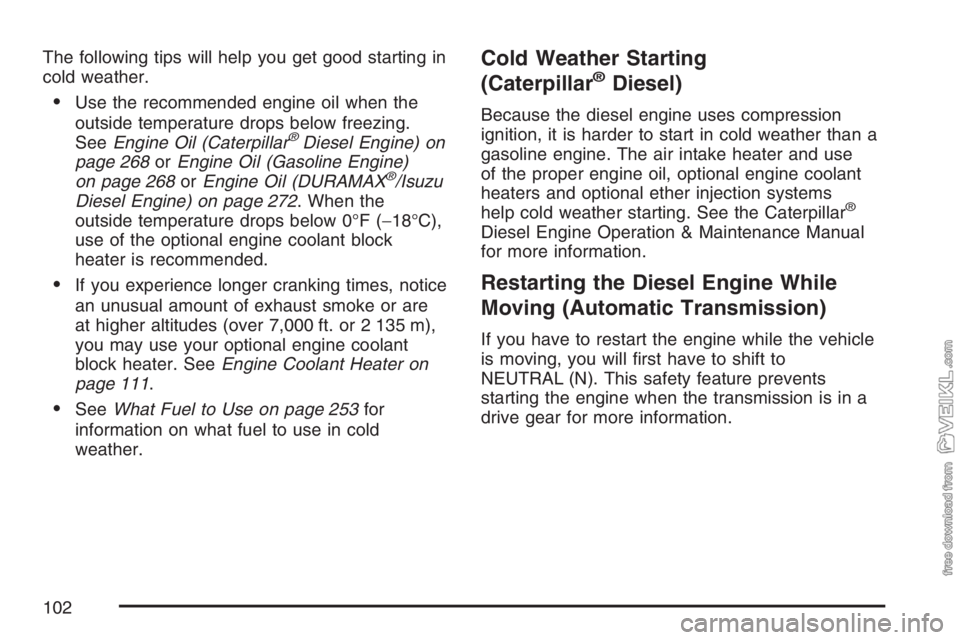
The following tips will help you get good starting in
cold weather.
•Use the recommended engine oil when the
outside temperature drops below freezing.
SeeEngine Oil (Caterpillar
®Diesel Engine) on
page 268orEngine Oil (Gasoline Engine)
on page 268orEngine Oil (DURAMAX
®/Isuzu
Diesel Engine) on page 272. When the
outside temperature drops below 0°F (−18°C),
use of the optional engine coolant block
heater is recommended.
•If you experience longer cranking times, notice
an unusual amount of exhaust smoke or are
at higher altitudes (over 7,000 ft. or 2 135 m),
you may use your optional engine coolant
block heater. SeeEngine Coolant Heater on
page 111.
•SeeWhat Fuel to Use on page 253for
information on what fuel to use in cold
weather.
Cold Weather Starting
(Caterpillar®Diesel)
Because the diesel engine uses compression
ignition, it is harder to start in cold weather than a
gasoline engine. The air intake heater and use
of the proper engine oil, optional engine coolant
heaters and optional ether injection systems
help cold weather starting. See the Caterpillar
®
Diesel Engine Operation & Maintenance Manual
for more information.
Restarting the Diesel Engine While
Moving (Automatic Transmission)
If you have to restart the engine while the vehicle
is moving, you will first have to shift to
NEUTRAL (N). This safety feature prevents
starting the engine when the transmission is in a
drive gear for more information.
102
Page 109 of 430
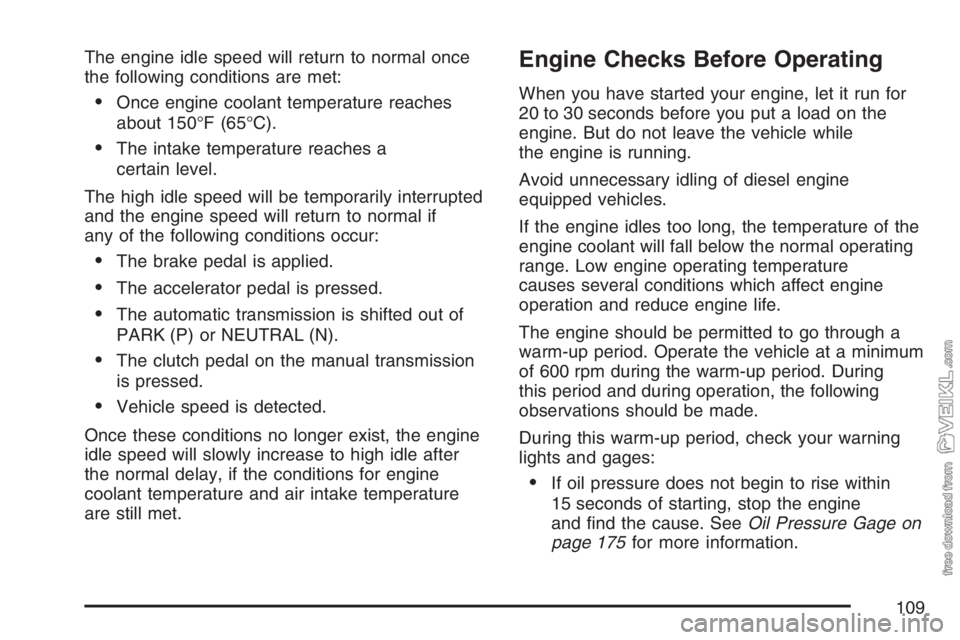
The engine idle speed will return to normal once
the following conditions are met:
•Once engine coolant temperature reaches
about 150°F (65°C).
•The intake temperature reaches a
certain level.
The high idle speed will be temporarily interrupted
and the engine speed will return to normal if
any of the following conditions occur:
•The brake pedal is applied.
•The accelerator pedal is pressed.
•The automatic transmission is shifted out of
PARK (P) or NEUTRAL (N).
•The clutch pedal on the manual transmission
is pressed.
•Vehicle speed is detected.
Once these conditions no longer exist, the engine
idle speed will slowly increase to high idle after
the normal delay, if the conditions for engine
coolant temperature and air intake temperature
are still met.
Engine Checks Before Operating
When you have started your engine, let it run for
20 to 30 seconds before you put a load on the
engine. But do not leave the vehicle while
the engine is running.
Avoid unnecessary idling of diesel engine
equipped vehicles.
If the engine idles too long, the temperature of the
engine coolant will fall below the normal operating
range. Low engine operating temperature
causes several conditions which affect engine
operation and reduce engine life.
The engine should be permitted to go through a
warm-up period. Operate the vehicle at a minimum
of 600 rpm during the warm-up period. During
this period and during operation, the following
observations should be made.
During this warm-up period, check your warning
lights and gages:
•If oil pressure does not begin to rise within
15 seconds of starting, stop the engine
and find the cause. SeeOil Pressure Gage on
page 175for more information.
109
Page 138 of 430
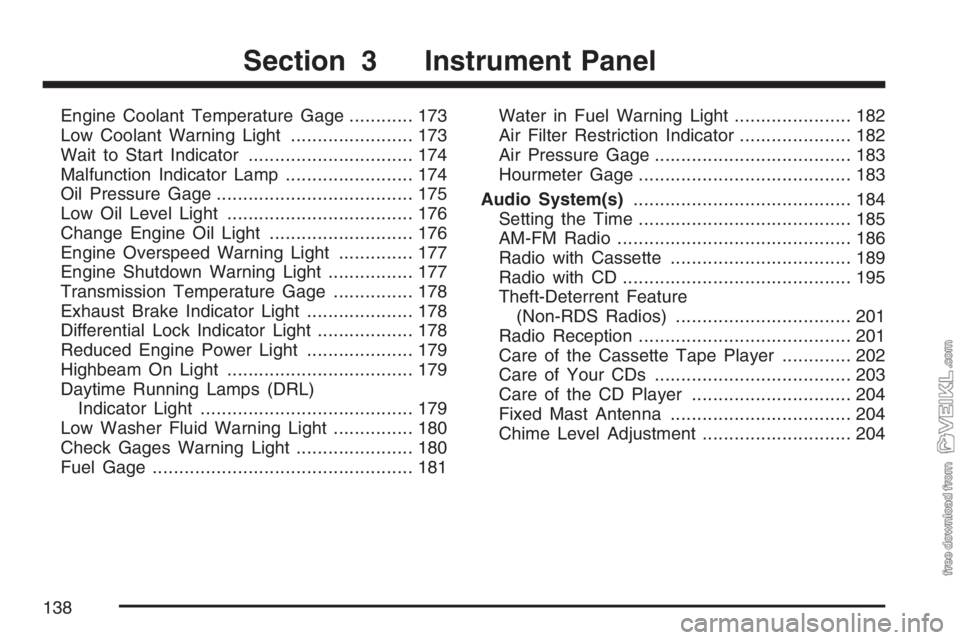
Engine Coolant Temperature Gage............ 173
Low Coolant Warning Light....................... 173
Wait to Start Indicator............................... 174
Malfunction Indicator Lamp........................ 174
Oil Pressure Gage..................................... 175
Low Oil Level Light................................... 176
Change Engine Oil Light........................... 176
Engine Overspeed Warning Light.............. 177
Engine Shutdown Warning Light................ 177
Transmission Temperature Gage............... 178
Exhaust Brake Indicator Light.................... 178
Differential Lock Indicator Light.................. 178
Reduced Engine Power Light.................... 179
Highbeam On Light................................... 179
Daytime Running Lamps (DRL)
Indicator Light........................................ 179
Low Washer Fluid Warning Light............... 180
Check Gages Warning Light...................... 180
Fuel Gage................................................. 181Water in Fuel Warning Light...................... 182
Air Filter Restriction Indicator..................... 182
Air Pressure Gage..................................... 183
Hourmeter Gage........................................ 183
Audio System(s)......................................... 184
Setting the Time........................................ 185
AM-FM Radio............................................ 186
Radio with Cassette.................................. 189
Radio with CD........................................... 195
Theft-Deterrent Feature
(Non-RDS Radios)................................. 201
Radio Reception........................................ 201
Care of the Cassette Tape Player............. 202
Care of Your CDs..................................... 203
Care of the CD Player.............................. 204
Fixed Mast Antenna.................................. 204
Chime Level Adjustment............................ 204
Section 3 Instrument Panel
138
Page 178 of 430
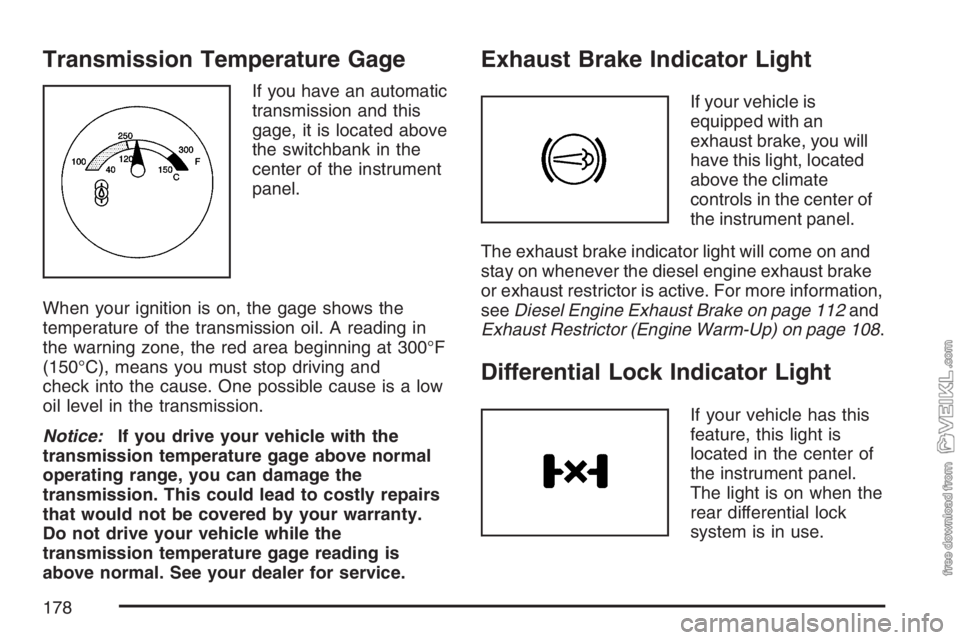
Transmission Temperature Gage
If you have an automatic
transmission and this
gage, it is located above
the switchbank in the
center of the instrument
panel.
When your ignition is on, the gage shows the
temperature of the transmission oil. A reading in
the warning zone, the red area beginning at 300°F
(150°C), means you must stop driving and
check into the cause. One possible cause is a low
oil level in the transmission.
Notice:If you drive your vehicle with the
transmission temperature gage above normal
operating range, you can damage the
transmission. This could lead to costly repairs
that would not be covered by your warranty.
Do not drive your vehicle while the
transmission temperature gage reading is
above normal. See your dealer for service.
Exhaust Brake Indicator Light
If your vehicle is
equipped with an
exhaust brake, you will
have this light, located
above the climate
controls in the center of
the instrument panel.
The exhaust brake indicator light will come on and
stay on whenever the diesel engine exhaust brake
or exhaust restrictor is active. For more information,
seeDiesel Engine Exhaust Brake on page 112and
Exhaust Restrictor (Engine Warm-Up) on page 108.
Differential Lock Indicator Light
If your vehicle has this
feature, this light is
located in the center of
the instrument panel.
The light is on when the
rear differential lock
system is in use.
178
Page 245 of 430
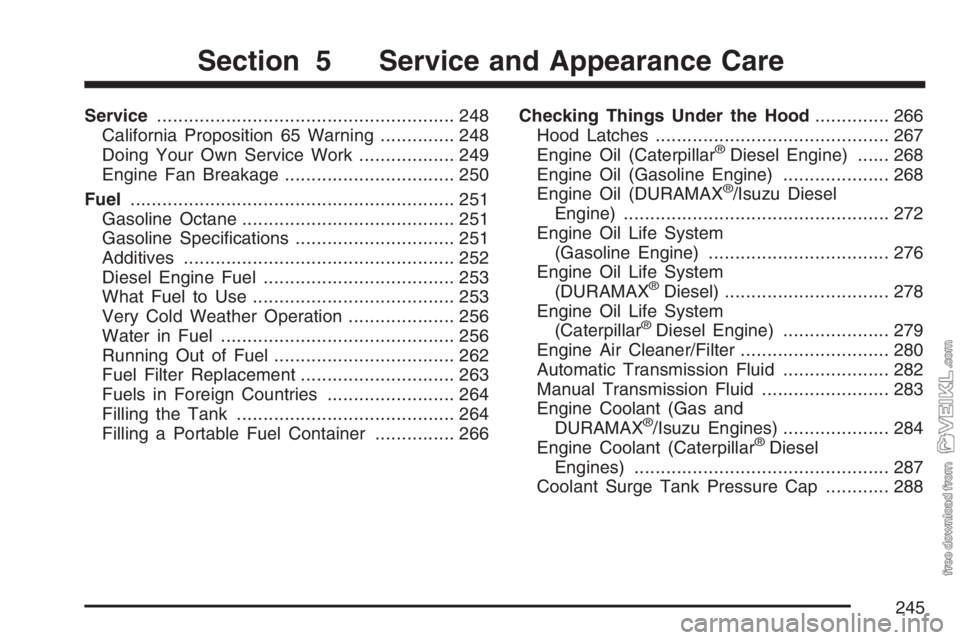
Service........................................................ 248
California Proposition 65 Warning.............. 248
Doing Your Own Service Work.................. 249
Engine Fan Breakage................................ 250
Fuel............................................................. 251
Gasoline Octane........................................ 251
Gasoline Specifications.............................. 251
Additives................................................... 252
Diesel Engine Fuel.................................... 253
What Fuel to Use...................................... 253
Very Cold Weather Operation.................... 256
Water in Fuel............................................ 256
Running Out of Fuel.................................. 262
Fuel Filter Replacement............................. 263
Fuels in Foreign Countries........................ 264
Filling the Tank......................................... 264
Filling a Portable Fuel Container............... 266Checking Things Under the Hood.............. 266
Hood Latches............................................ 267
Engine Oil (Caterpillar
®Diesel Engine)...... 268
Engine Oil (Gasoline Engine).................... 268
Engine Oil (DURAMAX
®/Isuzu Diesel
Engine).................................................. 272
Engine Oil Life System
(Gasoline Engine).................................. 276
Engine Oil Life System
(DURAMAX
®Diesel)............................... 278
Engine Oil Life System
(Caterpillar
®Diesel Engine).................... 279
Engine Air Cleaner/Filter............................ 280
Automatic Transmission Fluid.................... 282
Manual Transmission Fluid........................ 283
Engine Coolant (Gas and
DURAMAX
®/Isuzu Engines).................... 284
Engine Coolant (Caterpillar®Diesel
Engines)................................................ 287
Coolant Surge Tank Pressure Cap............ 288
Section 5 Service and Appearance Care
245
Page 253 of 430
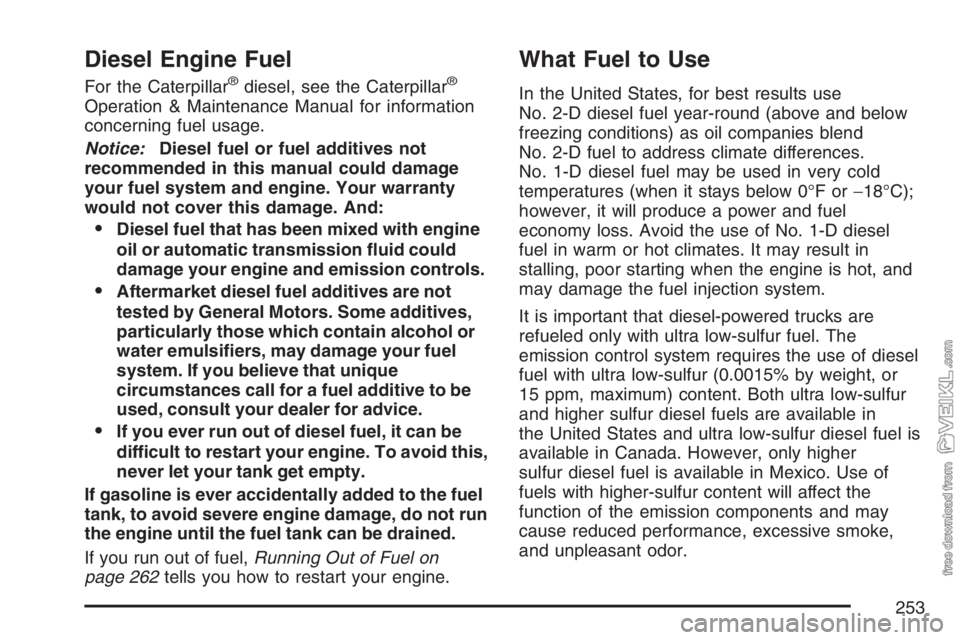
Diesel Engine Fuel
For the Caterpillar®diesel, see the Caterpillar®
Operation & Maintenance Manual for information
concerning fuel usage.
Notice:Diesel fuel or fuel additives not
recommended in this manual could damage
your fuel system and engine. Your warranty
would not cover this damage. And:
Diesel fuel that has been mixed with engine
oil or automatic transmission �uid could
damage your engine and emission controls.
Aftermarket diesel fuel additives are not
tested by General Motors. Some additives,
particularly those which contain alcohol or
water emulsi�ers, may damage your fuel
system. If you believe that unique
circumstances call for a fuel additive to be
used, consult your dealer for advice.
If you ever run out of diesel fuel, it can be
difficult to restart your engine. To avoid this,
never let your tank get empty.
If gasoline is ever accidentally added to the fuel
tank, to avoid severe engine damage, do not run
the engine until the fuel tank can be drained.
If you run out of fuel,Running Out of Fuel on
page 262tells you how to restart your engine.
What Fuel to Use
In the United States, for best results use
No. 2-D diesel fuel year-round (above and below
freezing conditions) as oil companies blend
No. 2-D fuel to address climate differences.
No. 1-D diesel fuel may be used in very cold
temperatures (when it stays below 0°F or−18°C);
however, it will produce a power and fuel
economy loss. Avoid the use of No. 1-D diesel
fuel in warm or hot climates. It may result in
stalling, poor starting when the engine is hot, and
may damage the fuel injection system.
It is important that diesel-powered trucks are
refueled only with ultra low-sulfur fuel. The
emission control system requires the use of diesel
fuel with ultra low-sulfur (0.0015% by weight, or
15 ppm, maximum) content. Both ultra low-sulfur
and higher sulfur diesel fuels are available in
the United States and ultra low-sulfur diesel fuel is
available in Canada. However, only higher
sulfur diesel fuel is available in Mexico. Use of
fuels with higher-sulfur content will affect the
function of the emission components and may
cause reduced performance, excessive smoke,
and unpleasant odor.
253
Page 282 of 430
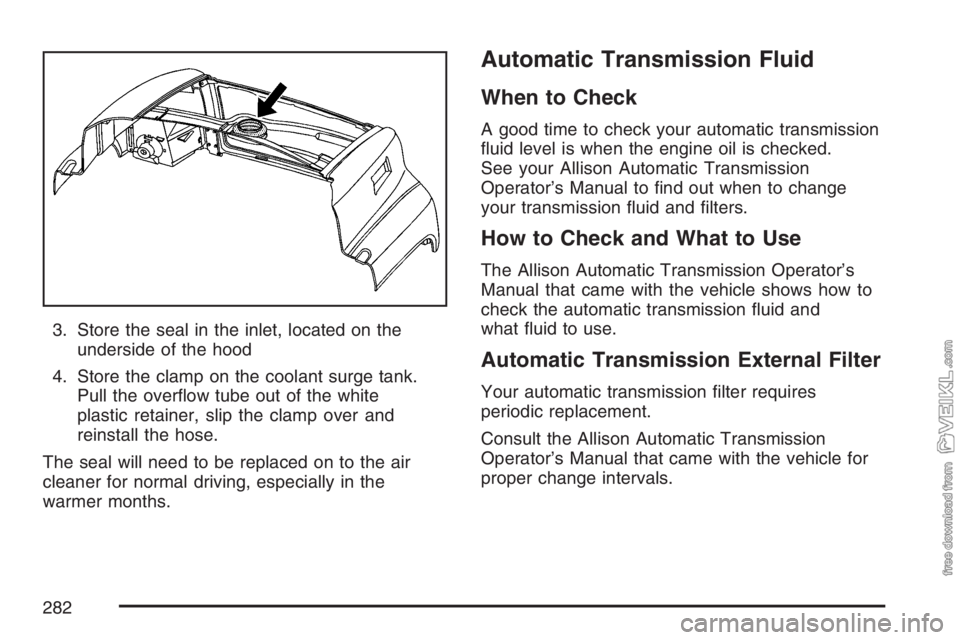
3. Store the seal in the inlet, located on the
underside of the hood
4. Store the clamp on the coolant surge tank.
Pull the overflow tube out of the white
plastic retainer, slip the clamp over and
reinstall the hose.
The seal will need to be replaced on to the air
cleaner for normal driving, especially in the
warmer months.
Automatic Transmission Fluid
When to Check
A good time to check your automatic transmission
fluid level is when the engine oil is checked.
See your Allison Automatic Transmission
Operator’s Manual to find out when to change
your transmission fluid and filters.
How to Check and What to Use
The Allison Automatic Transmission Operator’s
Manual that came with the vehicle shows how to
check the automatic transmission fluid and
what fluid to use.
Automatic Transmission External Filter
Your automatic transmission filter requires
periodic replacement.
Consult the Allison Automatic Transmission
Operator’s Manual that came with the vehicle for
proper change intervals.
282
Page 283 of 430
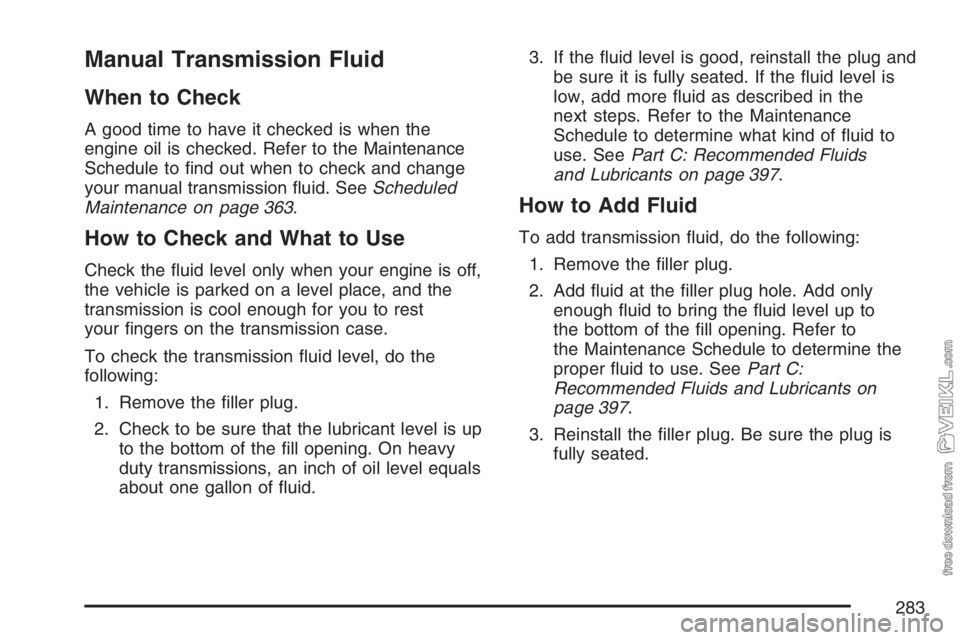
Manual Transmission Fluid
When to Check
A good time to have it checked is when the
engine oil is checked. Refer to the Maintenance
Schedule to find out when to check and change
your manual transmission fluid. SeeScheduled
Maintenance on page 363.
How to Check and What to Use
Check the fluid level only when your engine is off,
the vehicle is parked on a level place, and the
transmission is cool enough for you to rest
your fingers on the transmission case.
To check the transmission fluid level, do the
following:
1. Remove the filler plug.
2. Check to be sure that the lubricant level is up
to the bottom of the fill opening. On heavy
duty transmissions, an inch of oil level equals
about one gallon of fluid.3. If the fluid level is good, reinstall the plug and
be sure it is fully seated. If the fluid level is
low, add more fluid as described in the
next steps. Refer to the Maintenance
Schedule to determine what kind of fluid to
use. SeePart C: Recommended Fluids
and Lubricants on page 397.
How to Add Fluid
To add transmission fluid, do the following:
1. Remove the filler plug.
2. Add fluid at the filler plug hole. Add only
enough fluid to bring the fluid level up to
the bottom of the fill opening. Refer to
the Maintenance Schedule to determine the
proper fluid to use. SeePart C:
Recommended Fluids and Lubricants on
page 397.
3. Reinstall the filler plug. Be sure the plug is
fully seated.
283
Page 303 of 430
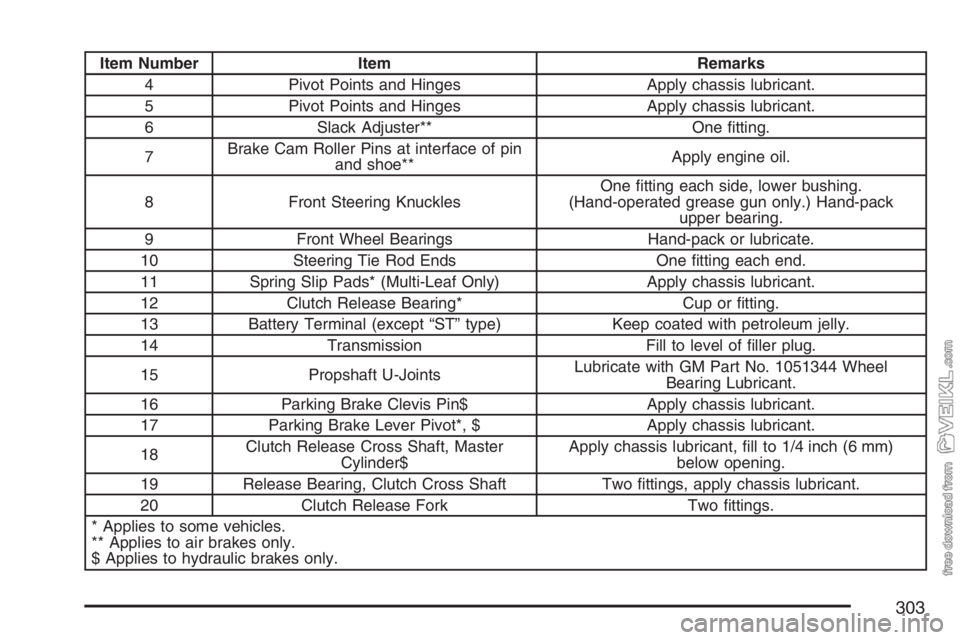
Item Number Item Remarks
4 Pivot Points and Hinges Apply chassis lubricant.
5 Pivot Points and Hinges Apply chassis lubricant.
6 Slack Adjuster** One fitting.
7Brake Cam Roller Pins at interface of pin
and shoe**Apply engine oil.
8 Front Steering KnucklesOne fitting each side, lower bushing.
(Hand-operated grease gun only.) Hand-pack
upper bearing.
9 Front Wheel Bearings Hand-pack or lubricate.
10 Steering Tie Rod Ends One fitting each end.
11 Spring Slip Pads* (Multi-Leaf Only) Apply chassis lubricant.
12 Clutch Release Bearing* Cup or fitting.
13 Battery Terminal (except “ST” type) Keep coated with petroleum jelly.
14 Transmission Fill to level of filler plug.
15 Propshaft U-JointsLubricate with GM Part No. 1051344 Wheel
Bearing Lubricant.
16 Parking Brake Clevis Pin$ Apply chassis lubricant.
17 Parking Brake Lever Pivot*, $ Apply chassis lubricant.
18Clutch Release Cross Shaft, Master
Cylinder$Apply chassis lubricant, fill to 1/4 inch (6 mm)
below opening.
19 Release Bearing, Clutch Cross Shaft Two fittings, apply chassis lubricant.
20 Clutch Release Fork Two fittings.
* Applies to some vehicles.
** Applies to air brakes only.
$ Applies to hydraulic brakes only.
303
Page 363 of 430
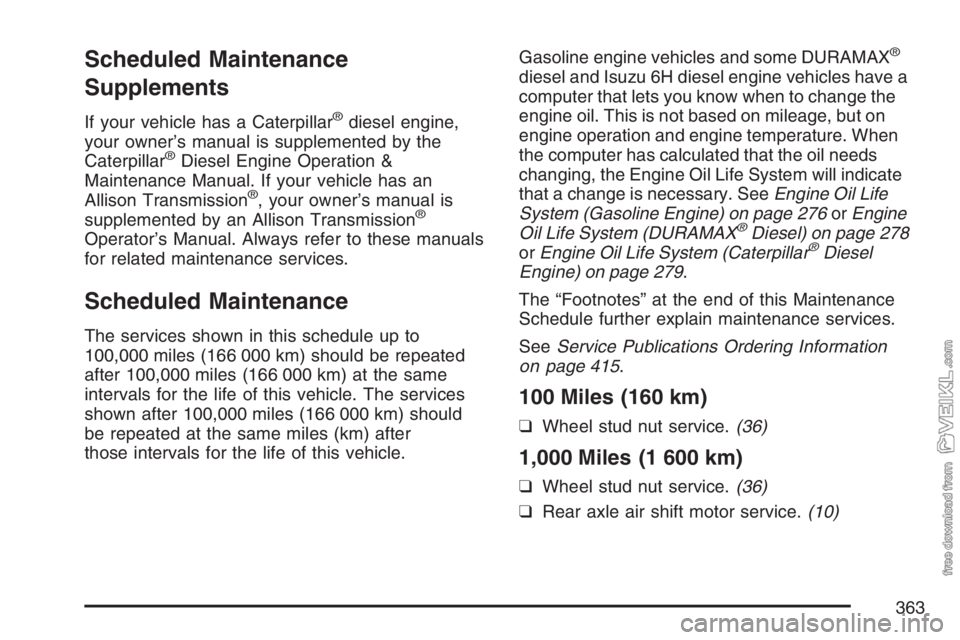
Scheduled Maintenance
Supplements
If your vehicle has a Caterpillar®diesel engine,
your owner’s manual is supplemented by the
Caterpillar
®Diesel Engine Operation &
Maintenance Manual. If your vehicle has an
Allison Transmission
®, your owner’s manual is
supplemented by an Allison Transmission®
Operator’s Manual. Always refer to these manuals
for related maintenance services.
Scheduled Maintenance
The services shown in this schedule up to
100,000 miles (166 000 km) should be repeated
after 100,000 miles (166 000 km) at the same
intervals for the life of this vehicle. The services
shown after 100,000 miles (166 000 km) should
be repeated at the same miles (km) after
those intervals for the life of this vehicle.Gasoline engine vehicles and some DURAMAX
®
diesel and Isuzu 6H diesel engine vehicles have a
computer that lets you know when to change the
engine oil. This is not based on mileage, but on
engine operation and engine temperature. When
the computer has calculated that the oil needs
changing, the Engine Oil Life System will indicate
that a change is necessary. SeeEngine Oil Life
System (Gasoline Engine) on page 276orEngine
Oil Life System (DURAMAX
®Diesel) on page 278
orEngine Oil Life System (Caterpillar®Diesel
Engine) on page 279.
The “Footnotes” at the end of this Maintenance
Schedule further explain maintenance services.
SeeService Publications Ordering Information
on page 415.
100 Miles (160 km)
❑Wheel stud nut service.(36)
1,000 Miles (1 600 km)
❑Wheel stud nut service.(36)
❑Rear axle air shift motor service.(10)
363